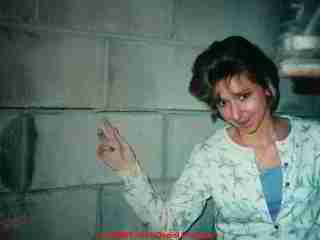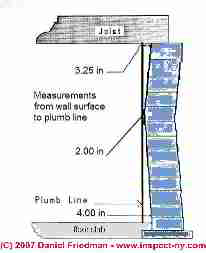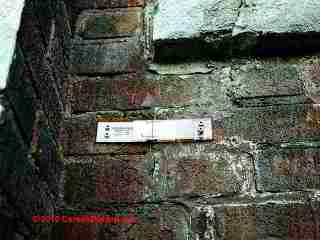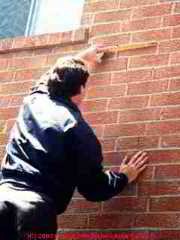 Foundation Crack Monitoring Methods & Devices
Foundation Crack Monitoring Methods & Devices
- POST a QUESTION or COMMENT about how to determine if foundation cracking or movement are active & if so, what is the rate of movement
Foundation crack movement monitoring devices & methods:
This document describes how foundation or slab cracks can be monitored for evidence of movement and what general advice makes sense for building owners or buyers where foundation damage is found and/or where further foundation inspection, testing, diagnosis, or repair appear warranted based on a general field inspection.
We include discussion of methods used to perform ongoing monitoring of building foundations for cracking and movement.
InspectAPedia tolerates no conflicts of interest. We have no relationship with advertisers, products, or services discussed at this website.
- Daniel Friedman, Publisher/Editor/Author - See WHO ARE WE?
Methods for Monitoring Foundations for Evidence of Ongoing or Episodic Movement
 Building foundations may be moving, either continuously or episodically. Most movement is episodic, that is, the movement is not a simple and continuous creep but rather foundation movement or cracking occurs in fits and starts.
Building foundations may be moving, either continuously or episodically. Most movement is episodic, that is, the movement is not a simple and continuous creep but rather foundation movement or cracking occurs in fits and starts.
Our sketch (left) shows a bulged masonry block foundation wall that has bowed in two inches at its innermost point.)
Usually foundation movement and further cracking occurs in response to occurrences of what has caused the cracking in the first place.
See FOUNDATION DAMAGE SEVERITY and
then FOUNDATION MOVEMENT ACTIVE vs. STATIC for distinguishing severe and also ongoing foundation movements.
Examples of Causes of Ongoing Foundation Damage/Movement
- Continuous vehicle traffic too close to the foundation (weight) or even in a nearby roadway (vibration)
- Continuous blasting and nearby site work
- Continuous overloading or point loading on the foundation due to construction or building design
On occasion a foundation cracked or damaged by an event (drove a heavy vehicle too close to the masonry block foundation wall) may later move, crack or bend, buckle, lean, bulge, etc. in response to other site conditions that it was previously able to resist before it was weakened by the original damage (frost, water, other vehicles).
Examples of Episodic or Discontinuous Causes of Foundation Damage/Movement
- Seasonal area flooding of surface water or subsurface groundwater
- Seasonal freezing weather - frost heaving and frost lensing
List of Simple Methods to Monitor a Masonry Foundation for Evidence of New or Ongoing Movement
- Crack Pins to monitor masonry structure movement: a metal pin is secured to the masonry surface on either side of the crack. Periodic measurements are made of the distance between the two points of the pins.

- Crack monitor slide devices: such as a glass slide, a more complex set of moving glass slides that include fine markings can be epoxied (or mechanically fastened) acros
s a building foundation crack.
Masonry crack monitoring devices provide accurate indication of any additional movement in the foundation wall. Beware: small amounts of foundation movement occur in masonry materials as a normal effect of temperature and moisture changes and may be typicallyi a millimeter or so. Don't mistake these causes for ongoing building movement. (Photo above courtesy of Avongard.)

- The Avongard CRACK MONITORING DEVICE, [Image] a $16.00 U.S. device measuring 1.25" x 5.75", is an example of this product. "The Avongard Crack Monitor consists of two overlapping acrylic plates. One plate is white with a black millimeter grid, while the other is transparent with red cross hairs centered over the grid.
Once the Crack Monitor is in position across a crack, the cross hairs shift vertically or horizontally on the grid if movement occurs,so that anyone can easily see and track crack movement." (Photo at left of a crack monitor in place is courtesy of Carson Dunlop Associates, a Toronto home inspection, education & report writing tool company [ carsondunlop.com ].)
The Avongard crack monitor can identify masonry wall movements down to 0.5mm and can handle total movement of 30.75" in crack width and 0.375" upwards movement (one side of the surface lifting or protruding past the other, such as on a concrete floor).
For longer term monitoring of a cracked masonry wall or floor we like this device. The monitor can also be used to measure movements in foundation corners by incorporating an angle bracket. Avongard provides a movement progress chart that permits logging of observations over time. - Masonry Crack Fillers:
if a horizontal, vertical, or diagonal masonry crack is filled with hard masonry patching compound, any substantial future movement is likely to show up as a new crack in the patched area (or nearby). Beware: some masonry products shrink when they dry and cure - don't mistake a patch shrinkage crack for building movement. But if a foundation crack is leaking you'll want to seal it, not just monitor it. - Masonry Crack Caulks:
filling a foundation crack with a masonry caulk is a quick, inexpensive, and effective way to seal the crack; some caulks, such as pourable sealant used to close floor cracks during radon mitigation work, are easy and effective to use. Beware: flexible materials won't show small amounts of future building movement.
- Measure and Document Foundation Movement:
masonry foundation cracks alone may not be the only nor even the most critical evidence of foundation movement. If a foundation wall is leaning, bending, or bowing, that stress may have resulted in several small width cracks that do not adequately describe the total amount of foundation movement.
A written and photo inventory of foundation cracks, simple measurement of foundation crack length and width as well as documenting their location, may be combined with simple measurements of the total lean or bulge in a foundation wall. - (Photo courtesy Carson Dunlop Associates ).
See FOUNDATION BULGE or LEAN MEASUREMENTS for details. - A foundation inspection & diagnostic report:
a thoughtful inspection of the building and site as well as an inventory of existing cracks permits a diagnosis of the causes of foundation damage as well as its extent. If there is evidence of significant foundation movement, we recommend that you take this more costly step.
See FOUNDATION CRACK DICTIONARY for guidance. - Other foundation movement monitoring devices
are used by professional engineers, including load cells or pressure cells, extensometers used with a borehole and tape, tilt meters that measure angular change or lean, strain meters, beam sensors, and soil movement sensors. - Companies such as Slope Indicator sell these and other sensing and measuring devices.
- U.S. GSA, MONITORING AND EVALUATING CRACKS IN MASONRY [PDF] (2016) Retrieved 2020/12/14
Excerpts:
This standard includes guidance on monitoring and evaluating cracks in masonry. Three different methods are described and include the following:
Using tape and a pencil, Using glass and epoxy, and Using the Avongard Crack Monitor.
Cracks in masonry are evidence that the building material has moved or is still moving, (active cracking).
Some causes of cracking include: settlement or foundation erosion, decay of materials, "vandalism" by renovators, structural failure, change in materials or geometry, and moisture and temperature changes.
In foundation piers and piles, general cracking is often due to settlement or rotation of the pier footing.
Vertical cracking or bulging of a masonry foundation wall is often due to physical deterioration of the pier from exposure, poor construction or overstressing.
Horizontal cracking or bowing of a masonry foundation wall may be caused by improper backfilling, or by swelling or freezing and heaving of water saturated soils adjacent to the wall.
Differential settlement of a masonry foundation wall may be caused by many different things including soil consolidation, soil shrinkage, soil swelling, soil heaving, soil erosion or soil compaction.
Differential settlement of a chimney is often caused by inadequate foundations which may cause the chimney to lean and crack.
...
Continue reading at DIAGONAL CRACKS in BLOCK FOUNDATIONS, WALLS or select a topic from the closely-related articles below, or see the complete ARTICLE INDEX.
Or see these
Recommended Articles
Suggested citation for this web page
CRACK MONITORING Methods at InspectApedia.com - online encyclopedia of building & environmental inspection, testing, diagnosis, repair, & problem prevention advice.
Or see this
INDEX to RELATED ARTICLES: ARTICLE INDEX to BUILDING STRUCTURES
Or use the SEARCH BOX found below to Ask a Question or Search InspectApedia
Ask a Question or Search InspectApedia
Questions & answers or comments about devices used to monitor cracks in masonry or concrete foundations & walls: sources, uses, interpretation of results. .
Try the search box just below, or if you prefer, post a question or comment in the Comments box below and we will respond promptly.
Search the InspectApedia website
Note: appearance of your Comment below may be delayed: if your comment contains an image, photograph, web link, or text that looks to the software as if it might be a web link, your posting will appear after it has been approved by a moderator. Apologies for the delay.
Only one image can be added per comment but you can post as many comments, and therefore images, as you like.
You will not receive a notification when a response to your question has been posted.
Please bookmark this page to make it easy for you to check back for our response.
IF above you see "Comment Form is loading comments..." then COMMENT BOX - countable.ca / bawkbox.com IS NOT WORKING.
In any case you are welcome to send an email directly to us at InspectApedia.com at editor@inspectApedia.com
We'll reply to you directly. Please help us help you by noting, in your email, the URL of the InspectApedia page where you wanted to comment.
Citations & References
In addition to any citations in the article above, a full list is available on request.
- "Concrete Slab Finishes and the Use of the F-number System", Matthew Stuart, P.E., S.E., F.ASCE, online course at www.pdhonline.org/courses/s130/s130.htm
- Avongard crack monitors, Santa Monica, CA 90406, 800-244-7241 can be reached by email to info@avongard.com
- Slope Indicator Company, 12123 Harbour Reach Dr., Mukilteo, WA, USA 98275 425-493-6200 can be reached by email to solutions@slope.com
- Sal Alfano - Editor, Journal of Light Construction*
- Thanks to Alan Carson, Carson Dunlop, Associates, Toronto, for technical critique and some of the foundation inspection photographs cited in these articles
- Terry Carson - ASHI
- Mark Cramer - ASHI
- JD Grewell, ASHI
- Duncan Hannay - ASHI, P.E. *
- Mark Cramer Inspection Services Mark Cramer, Tampa Florida, Mr. Cramer is a past president of ASHI, the American Society of Home Inspectors and is a Florida home inspector and home inspection educator. Mr. Cramer serves on the ASHI Home Inspection Standards. Contact Mark Cramer at: 727-595-4211 mark@BestTampaInspector.com
- John Cranor [Website: /www.house-whisperer.com ] is an ASHI member and a home inspector (The House Whisperer) is located in Glen Allen, VA 23060. He is also a contributor to InspectApedia.com in several technical areas such as plumbing and appliances (dryer vents). Contact Mr. Cranor at 804-873-8534 or by Email: johncranor@verizon.net
- Bob Klewitz, M.S.C.E., P.E. - ASHI
- Ken Kruger, P.E., AIA - ASHI
- Aaron Kuertz aaronk@appliedtechnologies.com, with Applied Technologies regarding polyurethane foam sealant as other foundation crack repair product - 05/30/2007
- Bob Peterson, Magnum Piering - 800-771-7437 - FL*
- Arlene Puentes, ASHI, October Home Inspections - (845) 216-7833 - Kingston NY
- Greg Robi, Magnum Piering - 800-822-7437 - National*
- Dave Rathbun, P.E. - Geotech Engineering - 904-622-2424 FL*
- Ed Seaquist, P.E., SIE Assoc. - 301-269-1450 - National
- Dave Wickersheimer, P.E. R.A. - IL, professor, school of structures division, UIUC - University of Illinois at Urbana-Champaign School of Architecture. Professor Wickersheimer specializes in structural failure investigation and repair for wood and masonry construction. * Mr. Wickersheimer's engineering consulting service can be contacted at HDC Wickersheimer Engineering Services. (3/2010)
- *These reviewers have not returned comment 6/95
ADDITIONAL READING about Foundation Failure Diagnosis & Repair
- Diagnosing & Repairing House Structure Problems, Edgar O. Seaquist, McGraw Hill, 1980 ISBN 0-07-056013-7 (obsolete, incomplete, missing most diagnosis steps, but very good reading; out of print but used copies are available at Amazon.com, and reprints are available from some inspection tool suppliers). Ed Seaquist was among the first speakers invited to a series of educational conferences organized by D Friedman for ASHI, the American Society of Home Inspectors, where the topic of inspecting the in-service condition of building structures was first addressed.
- Design of Wood Structures - ASD, Donald E. Breyer, Kenneth Fridley, Kelly Cobeen, David Pollock, McGraw Hill, 2003, ISBN-10: 0071379320, ISBN-13: 978-0071379328
This book is an update of a long-established text dating from at least 1988 (DJF); Quoting:
This book is gives a good grasp of seismic design for wood structures. Many of the examples especially near the end are good practice for the California PE Special Seismic Exam design questions. It gives a good grasp of how seismic forces move through a building and how to calculate those forces at various locations. THE CLASSIC TEXT ON WOOD DESIGN UPDATED TO INCLUDE THE LATEST CODES AND DATA. Reflects the most recent provisions of the 2003 International Building Code and 2001 National Design Specification for Wood Construction. Continuing the sterling standard set by earlier editions, this indispensable reference clearly explains the best wood design techniques for the safe handling of gravity and lateral loads. Carefully revised and updated to include the new 2003 International Building Code, ASCE 7-02 Minimum Design Loads for Buildings and Other Structures, the 2001 National Design Specification for Wood Construction, and the most recent Allowable Stress Design. - Building Failures, Diagnosis & Avoidance, 2d Ed., W.H. Ransom, E.& F. Spon, New York, 1987 ISBN 0-419-14270-3
- Forensic Geotechnical and Foundation Engineering, Robert W. Day, McGraw-Hill Professional, 1998, ISBN 0070164444, 9780070164444, 460 pp. Mr. Day discusses the Avongard crack monitors and other foundation monitoring methods - p. 48-49.
- Domestic Building Surveys, Andrew R. Williams, Kindle book, Amazon.com
- Defects and Deterioration in Buildings: A Practical Guide to the Science and Technology of Material Failure, Barry Richardson, Spon Press; 2d Ed (2001), ISBN-10: 041925210X, ISBN-13: 978-0419252108. Quoting:
A professional reference designed to assist surveyors, engineers, architects and contractors in diagnosing existing problems and avoiding them in new buildings. Fully revised and updated, this edition, in new clearer format, covers developments in building defects, and problems such as sick building syndrome. Well liked for its mixture of theory and practice the new edition will complement Hinks and Cook's student textbook on defects at the practitioner level. - Guide to Domestic Building Surveys, Jack Bower, Butterworth Architecture, London, 1988, ISBN 0-408-50000 X
- "Avoiding Foundation Failures," Robert Marshall, Journal of Light Construction, July, 1996 (Highly recommend this article-DF)
- "A Foundation for Unstable Soils," Harris Hyman, P.E., Journal of Light Construction, May 1995
- "Backfilling Basics," Buck Bartley, Journal of Light Construction, October 1994
- "Inspecting Block Foundations," Donald V. Cohen, P.E., ASHI Reporter, December 1998. This article in turn cites the Fine Homebuilding article noted below.
- "When Block Foundations go Bad," Fine Homebuilding, June/July 1998
- InspectAPedia.com - The Free Home Inspection & Construction Diagnosis Public Information Website
- Journal of Light Construction articles are available on CD ROM from the Journal of Light Construction, www.bginet.com, 802-434-4747
- Building Failures, Diagnosis & Avoidance, 2d Ed., W.H. Ransom, E.& F. Spon, New York, 1987 ISBN 0-419-14270-3
- Domestic Building Surveys, Andrew R. Williams, Kindle book, Amazon.com
- Defects and Deterioration in Buildings: A Practical Guide to the Science and Technology of Material Failure, Barry Richardson, Spon Press; 2d Ed (2001), ISBN-10: 041925210X, ISBN-13: 978-0419252108. Quoting:
A professional reference designed to assist surveyors, engineers, architects and contractors in diagnosing existing problems and avoiding them in new buildings. Fully revised and updated, this edition, in new clearer format, covers developments in building defects, and problems such as sick building syndrome. Well liked for its mixture of theory and practice the new edition will complement Hinks and Cook's student textbook on defects at the practitioner level. - Guide to Domestic Building Surveys, Jack Bower, Butterworth Architecture, London, 1988, ISBN 0-408-50000 X
- "Avoiding Foundation Failures," Robert Marshall, Journal of Light Construction, July, 1996 (Highly recommend this article-DF)
- "A Foundation for Unstable Soils," Harris Hyman, P.E., Journal of Light Construction, May 1995
- "Backfilling Basics," Buck Bartley, Journal of Light Construction, October 1994
- "Inspecting Block Foundations," Donald V. Cohen, P.E., ASHI Reporter, December 1998. This article in turn cites the Fine Homebuilding article noted below.
- "When Block Foundations go Bad," Fine Homebuilding, June/July 1998
- Best Practices Guide to Residential Construction, by Steven Bliss. John Wiley & Sons, 2006. ISBN-10: 0471648361, ISBN-13: 978-0471648369, Hardcover: 320 pages, available from Amazon.com and also Wiley.com. See our book review of this publication.
- Building Pathology, Deterioration, Diagnostics, and Intervention, Samuel Y. Harris, P.E., AIA, Esq., ISBN 0-471-33172-4, John Wiley & Sons, 2001 [General building science-DF] ISBN-10: 0471331724 ISBN-13: 978-0471331728
- Building Pathology: Principles and Practice, David Watt, Wiley-Blackwell; 2 edition (March 7, 2008) ISBN-10: 1405161035 ISBN-13: 978-1405161039
- Construction Drawings and Details, Rosemary Kilmer
- Diagnosing & Repairing House Structure Problems, Edgar O. Seaquist, McGraw Hill, 1980 ISBN 0-07-056013-7 (obsolete, incomplete, missing most diagnosis steps, but very good reading; out of print but used copies are available at Amazon.com, and reprints are available from some inspection tool suppliers). Ed Seaquist was among the first speakers invited to a series of educational conferences organized by D Friedman for ASHI, the American Society of Home Inspectors, where the topic of inspecting the in-service condition of building structures was first addressed.
- Design of Wood Structures - ASD, Donald E. Breyer, Kenneth Fridley, Kelly Cobeen, David Pollock, McGraw Hill, 2003, ISBN-10: 0071379320, ISBN-13: 978-0071379328
This book is an update of a long-established text dating from at least 1988 (DJF); Quoting:
This book is gives a good grasp of seismic design for wood structures. Many of the examples especially near the end are good practice for the California PE Special Seismic Exam design questions. It gives a good grasp of how seismic forces move through a building and how to calculate those forces at various locations. THE CLASSIC TEXT ON WOOD DESIGN UPDATED TO INCLUDE THE LATEST CODES AND DATA. Reflects the most recent provisions of the 2003 International Building Code and 2001 National Design Specification for Wood Construction. Continuing the sterling standard set by earlier editions, this indispensable reference clearly explains the best wood design techniques for the safe handling of gravity and lateral loads. Carefully revised and updated to include the new 2003 International Building Code, ASCE 7-02 Minimum Design Loads for Buildings and Other Structures, the 2001 National Design Specification for Wood Construction, and the most recent Allowable Stress Design. - Quality Standards for the Professional Remodeling Industry, National Association of Home Builders Remodelers Council, NAHB Research Foundation, 1987.
- Quality Standards for the Professional Remodeler, N.U. Ahmed, # Home Builder Pr (February 1991), ISBN-10: 0867183594, ISBN-13: 978-0867183597
- In addition to citations & references found in this article, see the research citations given at the end of the related articles found at our suggested
CONTINUE READING or RECOMMENDED ARTICLES.
- Carson, Dunlop & Associates Ltd., 120 Carlton Street Suite 407, Toronto ON M5A 4K2. Tel: (416) 964-9415 1-800-268-7070 Email: info@carsondunlop.com. Alan Carson is a past president of ASHI, the American Society of Home Inspectors.
Thanks to Alan Carson and Bob Dunlop, for permission for InspectAPedia to use text excerpts from The HOME REFERENCE BOOK - the Encyclopedia of Homes and to use illustrations from The ILLUSTRATED HOME .
Carson Dunlop Associates provides extensive home inspection education and report writing material. In gratitude we provide links to tsome Carson Dunlop Associates products and services.


